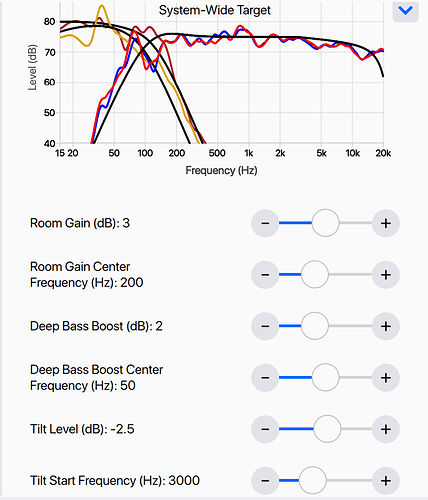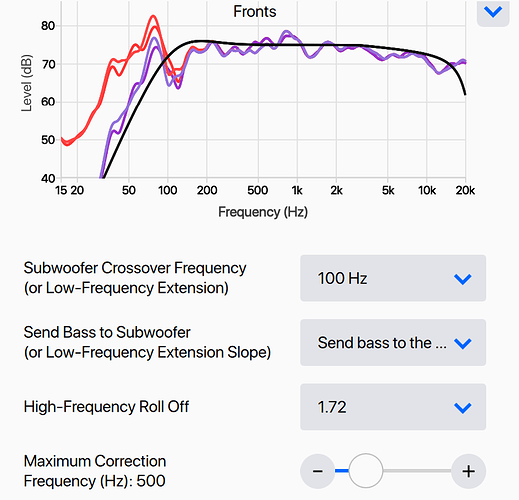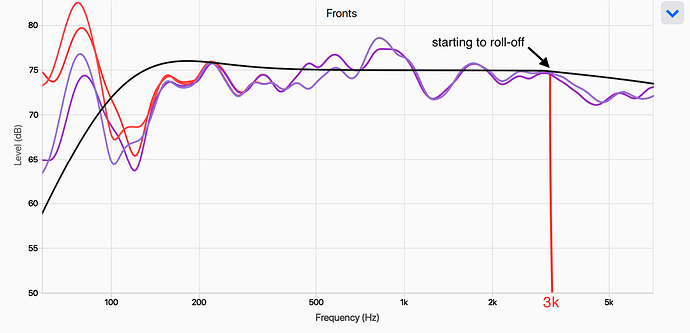TIPS ON ADVANCE ARC SETTINGS
Here’s my tips for the advanced settings. As always, you should try to see if it works for you as every room is unique and the results is contingent on the ARC calibration results. As the saying goes, “garbage in, garbage out”…The advanced setting can only help to smooth out the “rough edges” and make it sound more “refined” than the default settings. With that out of the way, let’s dive in…
I will be using my mains (KEF R100) in this segment.
Tilt Start Frequency
By default, the Tilt Start Frequency range is set at 100Hz. This isn’t always ideal but it is not hard to see why 100Hz since ARC crossover my Mains at 100Hz.
The black curve is the “Target Curve” much like Dirac setting an optimum target curve for the “corrected” frequency curve to follow as close as possible. If we zoom in further on the graph, we can see that my KEF R100 starts to roll-off at about 2,800Hz to 3KHz thereabouts.
Use 3KHz as the roll-off point, we will set the Tilt Start Frequency to roll-off at the same frequency so that the target curve will stick to the natural frequency roll-off of my Mains. Next, adjust your Tilt Level (dB) to get the target curve to touch the “corrected” (purple) frequency curve. I ended up with -2.5dB.
Room Gain
As mentioned in my last post, you can set the Room Gain at 3dB as a baseline starting point. Adjust either up or down depending on how much bass energy you want. You will know it after playing some of your favourite movie and music content with a fair amount of bass in the content.
Room Gain Center Frequency
By default, ARC sets mine at 200Hz (for me, not sure it will be different for others though). This is a crucial point for getting the chest slamming bass and the overall bass energy right. You will need to experiment with the different setting. In a nutshell, if you “shift” the Room Gain Center to lower, say 150Hz, there will be a drop in the overall SPL level and that helps with “boomy and bloated bass” a lot. Conversely, if you want more “rumble” and a “fuller” and more “energetic” bass, you can shift the centre to 200Hz or higher. As you have guess it by now, both Room Gain and Room Gain Center settings are interconnected. If you find the bass to be too “boomy” which drowns out the surround effects or make the dialogue muffled, you can either lower the Room Gain or shift its centre to 150Hz (minimum). Again, experiment is the key…it is your room, your speakers and your subwoofers. Experiment until you get a good combination of both.
Deep Bass Boost
This setting is specifically made for what I will called “bum shaking” and “pants flapping” bass. It generally affects the sub-modal frequency range (20Hz - 50Hz) where bass is not localisable. For those who wanted to have a “bass-shaking” effects, this is the setting that you will want to play with. I have set mine at 2dB. Since I already have a bass shakers installed behind my 2-seater, I need not push it too hard.
Maximum Correction Frequency
I have briefly touched on this in my last post as well. If you feel that the sound stage is not wide or there is a lack of that “cinematic” scope or feel when watching a blockbuster movie, try to lower it from the default 5KHz to 500Hz. It will make a drastic difference. The theory goes that over-correction for a good pair of Mains can actually “rob” you of the dynamics of your speakers. This is especially so when your Mains are a very capable pair of speakers. Besides, correcting the frequency range to achieve a flatter response may actually be counter-intuitive since any correction above 250Hz - 500Hz may unwittingly destroy the dynamics of your speakers.
Try the above advanced tips and let me know whether it works for you… 


